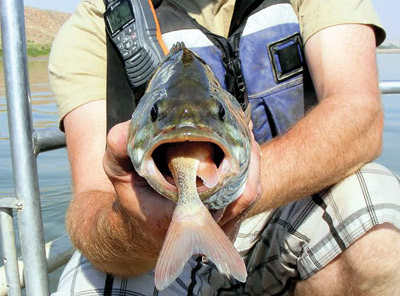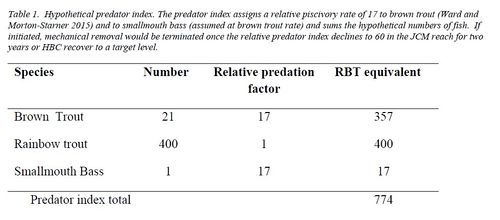Nonnative Invasive Aquatic Species
|
|
Nonnative Invasive Aquatic SpeciesNon-native fish species present in Grand Canyon were mostly established as a result of intentional stocking to develop sport fisheries in the Colorado River and its tributaries during the late 1800s and early 1900s. Impacts of these actions was not fully understood until later in the 20th Century when a shift to native species conservation management occurred in the NPS. Negative impacts of non-native fish and altered habitats on native fish species has been well-documented throughout the world. Over 20 non-native fish species have been documented in GCNP; However, the more common, large-bodied, species of management concern include rainbow and brown trout, common carp, channel catfish, and bullhead species, striped and smallmouth bass. These species are known predators on native fish or native fish eggs or compete with native fish species. (NPS CFMP-EA_Pg 62) (17 warmwater species, 2 coldwater species, and 1 coolwater species)--- At least 7 additional species occur in nearby or adjoining waters with potential access to the Glen Canyon Ecosystem. LTEMP Resource Goal for Nonnative Invasive SpeciesMinimize or reduce the presence and expansion of aquatic nonnative invasive species. |
| |
Fish of the Colorado River below Glen Canyon Dam - GCDAMP training prepared by AZFGD |
|
|---|
Smallmouth bass, brown trout, and green sunfish have recently established themselves in Glen Canyon raising concerns for management of Federally-listed fish like humpback chub further downstream. LTEMP Experimental Action: Aquatic Resource-Related Experimental Treatments (BA, pages 30-41) [1]Nonnative fish control actions would be implemented if the Little Colorado River humpback chub population declined and proactive conservation actions failed to reverse declining populations [2]. Mechanical removal of nonnative species is a controversial issue in the Colorado River through Glen and Grand Canyons. A spring 2015 meeting of Grand Canyon biologists (NPS, FWS, AGFD, GCMRC) to assess current trout removal triggers resulted in a concept of early conservation measure intervention to maximize conservation benefit to humpback chub and minimize the likelihood of mechanical predator removal. Under the preferred alternative, mechanical removal of nonnative rainbow and brown trout (and other nonnative predators) would be implemented through a triggered, tiered approach (see Appendix D in BA) near the confluence of the Little Colorado River and the Colorado River if conservation actions designed to reverse declines in the Little Colorado River humpback chub aggregation were ineffective. Two different tiers of population metrics would be used to trigger responses such as actions to increase growth and survival of humpback chub (Conservation Actions, Tier 1), or mechanical nonnative fish control (Tier 2), which would only be implemented when Tier 1 conservation actions (actions would focus on increasing growth, survival and distribution of chub in the Little Colorado River and LCR mainstem aggregation area) fail to slow or reverse the decline in the humpback chub population (see Appendix D in BA, Young et al. 2015). In addition, if humpback chub decline and the identified actions are not working, the FWS, in coordination with action agencies and traditionally associated Tribes, will identify future appropriate actions (among other caveats specified in Young et al. 2015). LTEMP BiOp Conservation Measures to Control Nonnative Fishes [3] (2016)Ongoing actions: Reclamation, in collaboration with the NPS and FWS, and in consultation with the AZGFD, would investigate the possibility of renovating Bright Angel and Shinumo Creeks with a chemical piscicide, or other tools, as appropriate. Additional planning and compliance, and tribal consultation under Section 106 of the NHPA, would be required. This feasibility study is outlined in the NPS CFMP (2013; see “Feasibility Study for Use of Chemical Fish Control Methods”). The action benefits humpback chub and other native fish by removing nonnative fish that can predate upon and compete with humpback chub. The regulation and control of nonnative fish is a management action identified in the Humpback Chub Recovery Goals (USFWS 2002a) and Razorback Sucker Recovery Goals (USFWS 2002b). Reclamation would continue to fund efforts of the GCMRC and NPS to remove brown trout (and other nonnative species) from Bright Angel Creek and the Bright Angel Creek Inflow reach of the Colorado River, and from other areas where new or expanded spawning populations develop, consistent with the NPS CFMP. After 5 years of removal efforts are completed (in 2017), an analysis of success would be conducted. Piscicides may be considered for removal of nonnative species if determined to be appropriate and following completion of the necessary planning and compliance actions. The regulation and control of nonnative fish is a management action identified in the Humpback Chub Recovery Goals (USFWS 2002a) and Razorback Sucker Recovery Goals (USFWS 2002b). New actions: Reclamation would explore the efficacy of a temperature control device at the dam to respond to potential extremes in hydrological conditions due to climate conditions that could result in nonnative fish establishment. Evaluations would be ongoing for all current and evolving technological advances that could provide for warming and cooling the river in both high- and low-flow discharge scenarios, and high and low reservoir levels. These studies should include evaluating and pursuing new technologies, an analysis of the feasibility, and a risk assessment and cost analysis for any potential solutions. The regulation and control of nonnative fish is a management action identified in the Humpback Chub Recovery Goals (USFWS 2002a) and Razorback Sucker Recovery Goals (USFWS 2002b). Reclamation would pursue means of preventing the passage of deleterious invasive nonnative fish through Glen Canyon Dam. Because Glen Canyon Dam release temperatures are expected to be warmer under low reservoir elevations that may occur through the LTEMP period, options to hinder expansion of warmwater nonnative fishes into Glen and Grand Canyons would be evaluated. Potential options to minimize or eliminate passage through the turbine or bypass intakes, or minimize survival of nonnative fish that pass through the dam would be assessed (flows, provide cold water, other). While feasible options may not currently exist, technology may be developed during the LTEMP period that could help achieve this goal. The regulation and control of nonnative fish is a management action identified in the Humpback Chub Recovery Goals (USFWS 2002a) and Razorback Sucker Recovery Goals (USFWS 2002b). Reclamation would, in consultation with the FWS and AGFD, fund the NPS and GCMRC on the completion of planning and compliance to alter the backwater slough at River Mile (RM) 12 (commonly referred to as “Upper Slough”), making it unsuitable or inaccessible to warmwater nonnative species that can compete with and predate upon native fish, including humpback chub. Depending on the outcome of NPS planning and compliance, Reclamation would implement the plan in coordination with the FWS, AGFD, NPS and GCMRC. Additional coordination would be conducted to determine and access any habitats that may support warmwater nonnatives. The regulation and control of nonnative fish is a management action identified in the Humpback Chub Recovery Goals (USFWS 2002a) and Razorback Sucker Recovery Goals (USFWS 2002b). Reclamation would support the GCMRC and NPS in consultation with the FWS and AGFD on the completion of planning and compliance of a plan for implementing rapid response control efforts for newly establishing or existing deleterious invasive nonnative species within and contiguous to the action area. Control efforts may include chemical, mechanical, or physical methods. While feasible options may not currently exist, new technology or innovative methods may be developed in the LTEMP period that could help achieve this goal. Rapid response to new warmwater fish invasions may become a more frequent need in the future with lower reservoir elevations and warmer dam releases. The regulation and control of nonnative fish is a management action identified in the Humpback Chub Recovery Goals (USFWS 2002a) and Razorback Sucker Recovery Goals (USFWS 2002b). Reclamation, will consider, in consultation with the GCDAMP, the experimental use of TMFs to inhibit brown trout spawning and recruitment in Glen Canyon, or other mainstem locations. Inhibiting brown trout spawning and recruitment will benefit chub by reducing the potential for brown trout to predate upon humpback chub. The regulation and control of nonnative fish is a management action identified in the Humpback Chub Recovery Goals (USFWS 2002a) and Razorback Sucker Recovery Goals (USFWS 2002b). LTEMP BiOp Triggers for Nonnative Removals (LTEMP BA Appendix D)Tier 1 Trigger – Early Intervention Through Conservation Actions:
-OR-
Tier 1 Trigger Response:
Tier 2 Trigger - Reduce threat using mechanical removal if conservation actions in Tier 1 are insufficient to arrest a population decline:Mechanical removal of nonnative aquatic predator will ensue:
Mechanical removal will terminate if:
-OR-
If immigration rate of predators into JCM reach is high, mechanical removal may need to continue. These triggers are intended to be adaptive based on ongoing and future research (e.g., Lees Ferry recruitment and emigration dynamics, effects of trout suppression flows, effects of Paria River turbidity inputs on predator survival and immigration rates, interactions between humpback chub and rainbow trout, other predation studies).
|
|


